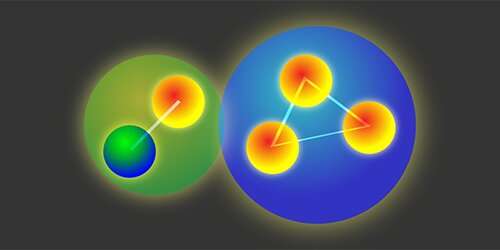Credit: APS/Carin Cain
A team of researchers working on the LHCb collaboration has found evidence showing that a pentaquark they have observed has a molecule-like structure. In their paper published in the journal Physical Review Letters, the group describes the evidence and the structure of the pentaquark they observed.
Four years ago, a team working at the Large Hadron Collider (LHC) observed what is known as a pentaquark by smashing protons into each other. Its existence had been theorized, but it was not until the right technology was deployed at the LHC that researchers were able to observe it with a reasonable degree of confidence. It was subsequently found to be a particle made up of four quarks and one antiquark. (Quarks are indivisible particles that make up neutrons and protons.)
In this new effort, the researchers have gained a better perspective on the actual organization of the pentaquark. They report that they have nine times as much data from observations as they had when the pentaquark was first observed, so they have high confidence in their findings. They report that the pentaquark was made up of a three-quark baryon and a quark-antiquark meson, and that they were bound together in a way reminiscent of a molecule.
More specifically, they found that the pentaquark was made up of different "flavors" of quarks—two up quarks, one down quark, one charm quark, and finally, a single anti-charm quark. They further report that they do not know what was the driving factor that led to the arrangement of its components. They also noted that the initial observation of the pentaquark three years ago was actually an observation of two pentaquarks that were nearly identical.
The researchers also report that their observations were the first ever to see baryons and mesons sticking together—until now, baryons have only been observed sticking to other baryons. They also acknowledge that it is conceivable that not all pentaquarks have the same molecular-type structure that they observed, noting that theory suggests it is possible for them to have other types, including split-second interactions. They hope more research will contribute to further understanding of the pentaquark and its characteristics.
More information: R. Aaij et al. Observation of a Narrow Pentaquark State, Pc(4312)+ , and of the Two-Peak Structure of the Pc(4450)+, Physical Review Letters (2019). DOI: 10.1103/PhysRevLett.122.222001 , arxiv.org/pdf/1904.03947.pdf
Journal information: Physical Review Letters
© 2019 Science X Network






















